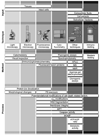Guidelines for the use and interpretation of assays for monitoring cell death in higher eukaryotes
- PMID: 19373242
- PMCID: PMC2757140
- DOI: 10.1038/cdd.2009.44
Guidelines for the use and interpretation of assays for monitoring cell death in higher eukaryotes
Abstract
Cell death is essential for a plethora of physiological processes, and its deregulation characterizes numerous human diseases. Thus, the in-depth investigation of cell death and its mechanisms constitutes a formidable challenge for fundamental and applied biomedical research, and has tremendous implications for the development of novel therapeutic strategies. It is, therefore, of utmost importance to standardize the experimental procedures that identify dying and dead cells in cell cultures and/or in tissues, from model organisms and/or humans, in healthy and/or pathological scenarios. Thus far, dozens of methods have been proposed to quantify cell death-related parameters. However, no guidelines exist regarding their use and interpretation, and nobody has thoroughly annotated the experimental settings for which each of these techniques is most appropriate. Here, we provide a nonexhaustive comparison of methods to detect cell death with apoptotic or nonapoptotic morphologies, their advantages and pitfalls. These guidelines are intended for investigators who study cell death, as well as for reviewers who need to constructively critique scientific reports that deal with cellular demise. Given the difficulties in determining the exact number of cells that have passed the point-of-no-return of the signaling cascades leading to cell death, we emphasize the importance of performing multiple, methodologically unrelated assays to quantify dying and dead cells.
Figures

References
-
- Kroemer G, Galluzzi L, Brenner C. Mitochondrial membrane permeabilization in cell death. Physiol Rev. 2007;87:99–163. - PubMed
-
- Northington FJ, Zelaya ME, O′Riordan DP, Blomgren K, Flock DL, Hagberg H, et al. Failure to complete apoptosis following neonatal hypoxia-ischemia manifests as “continuum” phenotype of cell death and occurs with multiple manifestations of mitochondrial dysfunction in rodent forebrain. Neuroscience. 2007;149:822–833. - PMC - PubMed
-
- Baehrecke EH. Autophagy: dual roles in life and death? Nat Rev Mol Cell Biol. 2005;6:505–510. - PubMed
Publication types
MeSH terms
Grants and funding
LinkOut - more resources
Full Text Sources
Other Literature Sources

